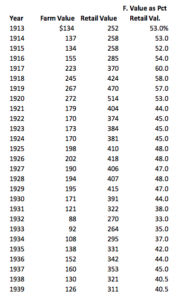by Mike Callicrate | May 18, 2018
1940: Farmers’ Share Does Not Increase As Price Margins Widen
Despite the efficiency of large-scale production, the farmer has continued to get a smaller and smaller share of the consumer’s dollar as monopoly control has increased over the past 25 years. An analysis of figures put out by the Bureau of Agricultural Economics shows that the margin going to the processors and distributors has swollen considerably over this period.
In a recent report the Agricultural Advisory Council stated that on food-stuffs alone the farmers are losing $2,000,000,000 a year because of the present disparity between farm prices and other prices.
While a one cent reduction in the farmer’s share of the consumer’s dollar seems like a trivial sum, the cumulative effect adds up to a staggering total. Thus, in the case of dairy products, the farmer’s share has dropped from 55 cents in 1913 to 42 cents in 1939. The effect of this shift is to reduce the income of dairy farmers by approximately a third of a billion dollars annually.
The farmer’s margin has decreased on practically all food products, but two most extreme cases are white flour and pork products. Though the farmer got 58 cents on the consumer’s flour dollar in 1913, this proportion had gradually dropped until by 1939 it was only 39 cents. In the case of pork products, the farmers had been getting 80 cents in 1913, but this had fallen by 57 cents by 1939.
The most striking point about middlemen’s margins is their rigidity and fixity in recent times. Price changes are passed either forward or backward, but absolute price spreads remain surprisingly constant despite vigorous changes in farm and retail prices.
Prior to 1915 the farmer received about 53 cents out of the consumer’s dollar spent for all foods. Durin gthe 20’s the farmer’s share dropped to about 47 cents. In 1938 and ’39 it remained unchanged at 40.5 cents.
These price spreads are figured in terms of a standard budget comprising 58 foods selected by the Department of Labor as typical of an average workingman’s family.
–courtesy of Tom Giessel














